Greetings, fellow SkyWatchers! Are you ready for another weekend under the stars? Then get out your telescopes and let’s go globular as we hunt down Messier Object 79. Polar weather got you down? Then let’s take a look at the pole stars both north and south and check into what Sir William Herschel was doing at this time of year. Then learn your history and I’ll meet you outside in the dark….
 Friday, January 16, 2009 – In 1978 on this date, NASA named 35 candidates for space shuttle missions, including Sally Ride as the first female U.S. astronaut and Guion Bluford, Jr., as the first black. In 1973, the Lunokhod 2 mission was beginning its robotic lunar expedition, and in 1969 Soyuz 4 and 5 became the first vehicles to dock in space and exchange cosmonauts. The year 1730 saw the birth of Jean Bochart – publisher of LaPlace’s planet/ecliptic theory. Although eventually beheaded for his politics, Bochart put together Europe’s largest collection of astronomical instruments and was renowned for his calculations of cometary orbits, made jointly with long-time friend and co-observer Charles Messier.
Friday, January 16, 2009 – In 1978 on this date, NASA named 35 candidates for space shuttle missions, including Sally Ride as the first female U.S. astronaut and Guion Bluford, Jr., as the first black. In 1973, the Lunokhod 2 mission was beginning its robotic lunar expedition, and in 1969 Soyuz 4 and 5 became the first vehicles to dock in space and exchange cosmonauts. The year 1730 saw the birth of Jean Bochart – publisher of LaPlace’s planet/ecliptic theory. Although eventually beheaded for his politics, Bochart put together Europe’s largest collection of astronomical instruments and was renowned for his calculations of cometary orbits, made jointly with long-time friend and co-observer Charles Messier.
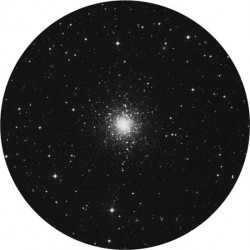 Tonight, venture into Lepus for a faint, round, fuzzy object that might easily be mistaken for a comet in a small telescope or binoculars—Messier Object 79 (RA 05 24 10 Dec +24 31 27). The true beauty of this object is revealed in large telescopes. Behold a globular cluster, one of many densely packed balls of stars that mainly congregate near our galactic center. Discovered by Pierre Mechain and cataloged by Messier in 1780, M79 is on the opposite side of our galaxy, and about 4,200 light-years away. Spanning 118 light-years, this starry sphere may not be an original member of our galaxy at all but an import. Although we can’t see it happening, the Canis Major Dwarf galaxy is slowly being incorporated into our own system, and M79 might very well be a product of this union!
Tonight, venture into Lepus for a faint, round, fuzzy object that might easily be mistaken for a comet in a small telescope or binoculars—Messier Object 79 (RA 05 24 10 Dec +24 31 27). The true beauty of this object is revealed in large telescopes. Behold a globular cluster, one of many densely packed balls of stars that mainly congregate near our galactic center. Discovered by Pierre Mechain and cataloged by Messier in 1780, M79 is on the opposite side of our galaxy, and about 4,200 light-years away. Spanning 118 light-years, this starry sphere may not be an original member of our galaxy at all but an import. Although we can’t see it happening, the Canis Major Dwarf galaxy is slowly being incorporated into our own system, and M79 might very well be a product of this union!
Thanks to Mechain and Messier’s careful notes, William Herschel later recovered M79 and resolved its stars. Although the practice of maintaining an astronomy diary isn’t for everyone, keeping simple records is very rewarding. Make note of the object’s appearance, equipment used, and sky conditions. Observing diaries just like those of Messier and Mechain have led countless astronomers along the road of discovery to all the deep-sky objects we know today!
 Saturday, January 17, 2009 – Celebrate the 1723 birthday of Johann Tobias Mayer, the German astronomer who created the first lunar tables for determining longitudes at sea. His calculations were accurate to within a half degree! If you’re up before sunrise, look at the Moon now nearing third quarter. How many lunar seas can you still identify? Can you navigate to Spica nearby?
Saturday, January 17, 2009 – Celebrate the 1723 birthday of Johann Tobias Mayer, the German astronomer who created the first lunar tables for determining longitudes at sea. His calculations were accurate to within a half degree! If you’re up before sunrise, look at the Moon now nearing third quarter. How many lunar seas can you still identify? Can you navigate to Spica nearby?
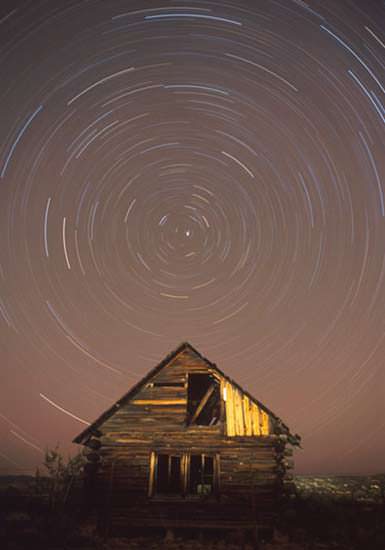
Ranked the 49th brightest star, Alpha Ursa Minoris may look ordinary but is not. Polaris is a Cepheid variable, a star that expands and contracts on a regular basis, changing its brightness slightly. Modern
interferometry has revealed it as slightly irregular—an ‘‘overtone pulsator’’—and a multiple one at that. Polaris’ triple system took the resolving power of the Hubble Space Telescope to reveal its spectroscopic component, but even a small telescope can spot its gravitationally bound blue companion!
The Southern Hemisphere also has a near-pole star—Sigma Octanis—but at magnitude 5 (300 times fainter than Polaris), it doesn’t make a good guide star. Ancient navigators found better success with the constellation Crux, better known as the Southern Cross. Its two brightest stars, Gacrux and acrux, are oriented north–south and point across the pole to brilliant Archenar. Splitting the distance between Gacrux and Archenar lands you within 2 degrees of the south celestial pole. A southern double star comparable to Polaris in appearance is Lambda Centauri. The difference in magnitude between components and separation are about the same!
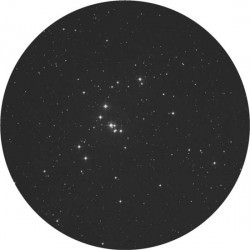 Sunday, January 18, 2009 – ‘‘I have looked farther into space than ever a human being did before me,’’ writes Sir William Herschel, discoverer of thousands of deep-sky objects. While 400 of these make up a popular observing list, many more deserve attention. This night in 1784, Herschel aimed his telescope toward Orion’s stars, and he found two new sky gems! Starting with binoculars, aim about 2 degrees northwest of the northernmost star in Orion’s ‘‘bow’’ (Pi1 Orionis) to view NGC 1662 (RA 04 48 24 Dec +10 56 00).
Sunday, January 18, 2009 – ‘‘I have looked farther into space than ever a human being did before me,’’ writes Sir William Herschel, discoverer of thousands of deep-sky objects. While 400 of these make up a popular observing list, many more deserve attention. This night in 1784, Herschel aimed his telescope toward Orion’s stars, and he found two new sky gems! Starting with binoculars, aim about 2 degrees northwest of the northernmost star in Orion’s ‘‘bow’’ (Pi1 Orionis) to view NGC 1662 (RA 04 48 24 Dec +10 56 00).
With a combined magnitude of 6, this small galactic cluster will show as a slight compression of the starfield, a challenging binocular deep-sky object. A small telescope at modest magnification will resolve NGC 1662 into a jewel-like chain of blue and gold stars. Astronomers have studied it extensively to refine its members’ proper motions, and it may have once contained more stars during its 300-million-year evolution!
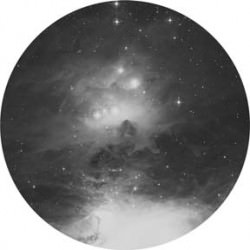 Now return to M42 and go slightly north (RA 05 35 15 Dec -04 53 12) to examine NGC 1977). Also discovered on this night by Herschel, seasoned sky veterans know this area by its nickname ‘‘the Running Man’’. Consisting of three separate areas of emission and reflection nebulae that seem to be visually connected, 1,500-light-year-distant NGC 1977/1975/1973 complex would be spectacular on its own if weren’t so close to M42! The conjoining nebula is whispery soft, its dark lanes created by interstellar dust and fine needle-like shards of carbon. Illuminating the gases is its fueling source, the multiple star 42 Orionis—a prized double on many lists. Through a telescope, this lovely triangle of bright nebulae and its several enshrouded stars make a wonderful region for exploration. Can you see the Running Man within?
Now return to M42 and go slightly north (RA 05 35 15 Dec -04 53 12) to examine NGC 1977). Also discovered on this night by Herschel, seasoned sky veterans know this area by its nickname ‘‘the Running Man’’. Consisting of three separate areas of emission and reflection nebulae that seem to be visually connected, 1,500-light-year-distant NGC 1977/1975/1973 complex would be spectacular on its own if weren’t so close to M42! The conjoining nebula is whispery soft, its dark lanes created by interstellar dust and fine needle-like shards of carbon. Illuminating the gases is its fueling source, the multiple star 42 Orionis—a prized double on many lists. Through a telescope, this lovely triangle of bright nebulae and its several enshrouded stars make a wonderful region for exploration. Can you see the Running Man within?
Until next week? Dreams really do come true… When you keep on reaching for the stars!
This week’s awesome images are: M79: Credit—Palomar Observatory, courtesy of Caltech, Sally Ride: Credit—NASA, ‘‘Turning Still’’: Credit—Joe Orman, Tobias Mayer (historical image), NGC 1662 and NGC 1977: Credit—Palomar Observatory, courtesy of Caltech. Thank you so much!

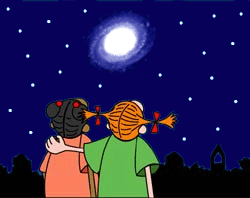
NGC 1662 is an excellent object. I had the opportunity to enjoy it earlier this week as part of my yearly Herschel 400 foray . Another over looked gem is a beautiful chain of stars that includes lamda (Meissa) on Orion’s head. I really enjoy objects that are hidden in the limelight of the more popular ones.
By the way Tammy your articles are always well done! Thanks.
Thank you both!
Did you know that Lambda or Meissa, is a young, spectral type O star located 1,100 light-years away? Given the great distance, ‘‘the Shining One’’ becomes one of the most luminous stars known. Use a telescope for a closer look! Formed from the molecular clouds in Orion, Meissa is young, hot, and massive, emitting enough ultraviolet light to transform all the hydrogen into ions within a 100 light-year radius. The faint nebulosity is the remnant of the cloud that spawned Lambda. But, look very closely. . . Meissa is a binary star system that has a magnitude 6 companion—a white hot, blue dwarf!
And you’re very right… scope out the bigger picture! Lambda appears associated with a group of stars. But is it? The answer is yes. Take a closer look with binoculars or a telescope at the open cluster Collinder 69 (RA 05 35 12 Dec +09 42 00). Estimated to be 10 million years old, this group of around 20 stars can be considered young on the stellar timescale. Containing little interior obscuring dust, clusters of its type are extremely important to studies of star formation. The young stars have not moved far from their original locations, and the group contains low-mass stars (close to the planetary limit), short-term variables, and brown dwarfs. You might not see everything Collinder 69 has to offer with good reason: associated with this interesting region are the dark nebulae Barnard 30/35 and Lynds 1588/1603!
Isn’t Joe’s work wonderful? His images capture something I just love… The “feel” of what it’s like to be out under starry skies. And right now, considering it’s -22 F in Ohio with blowing, drifiting snow, I’m doing good to “feel” anything!